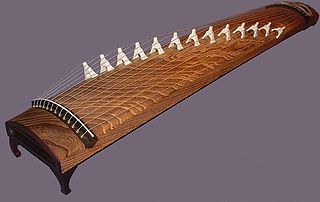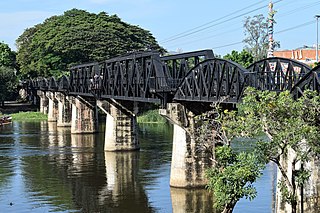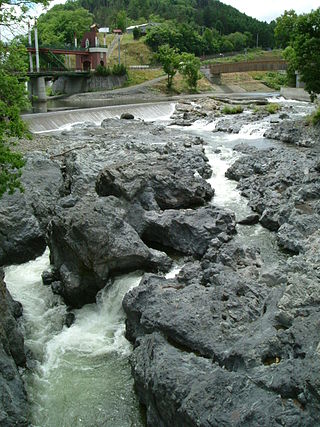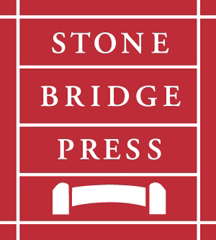Contents
| |||||
| Decades: | |||||
|---|---|---|---|---|---|
| See also: | Other events of 1660 History of Japan • Timeline • Years | ||||
Events in the year 1660 in Japan .
| |||||
| Decades: | |||||
|---|---|---|---|---|---|
| See also: | Other events of 1660 History of Japan • Timeline • Years | ||||
Events in the year 1660 in Japan .

The koto is a Japanese plucked half-tube zither instrument, and the national instrument of Japan. It is derived from the Chinese zheng and se, and similar to the Mongolian yatga, the Korean gayageum and ajaeng, the Vietnamese đàn tranh, the Sundanese kacapi and the Kazakh jetigen. Koto are roughly 180 centimetres (71 in) in length, and made from Paulownia wood. The most common type uses 13 strings strung over movable bridges used for tuning, different pieces possibly requiring different tuning. Seventeen-string koto are also common, and act as bass in ensembles. Koto strings are generally plucked using three fingerpicks, worn on the first three fingers of the right hand.

The Bridge on the River Kwai is a 1957 epic war film directed by David Lean and based on the 1952 novel written by Pierre Boulle. Boulle's novel and the film's screenplay are almost entirely fictional, but use the construction of the Burma Railway, in 1942–1943, as their historical setting. The cast includes William Holden, Alec Guinness, Jack Hawkins, and Sessue Hayakawa.

Honshu, historically called Akitsushima, is the largest and most populous island of Japan. It is located south of Hokkaidō across the Tsugaru Strait, north of Shikoku across the Inland Sea, and northeast of Kyūshū across the Kanmon Straits. The island separates the Sea of Japan, which lies to its north and west, from the North Pacific Ocean to the south and east. It is the seventh-largest island in the world, and the second-most populous after the Indonesian island of Java.

Shikoku, Japanese pronunciation:[ɕikokɯ] is the smallest of the four main islands of Japan. It is 225 km or 139.8 mi long and between 50 and 150 km or 31.1 and 93.2 mi at its widest. It has a population of 3.8 million, the least populated of Japan's four main islands. It is south of Honshu and northeast of Kyushu. Shikoku's ancient names include Iyo-no-futana-shima (伊予之二名島), Iyo-shima (伊予島), and Futana-shima (二名島), and its current name refers to the four former provinces that make up the island: Awa, Tosa, Sanuki, and Iyo.

The Burma Railway, also known as the Siam–Burma Railway, Thai–Burma Railway and similar names, or as the Death Railway, is a 415 km (258 mi) railway between Ban Pong, Thailand, and Thanbyuzayat, Burma. It was built from 1940 to 1943 by South East Asian civilians abducted and forced to work by the Japanese and a smaller group of captured Allied soldiers, to supply troops and weapons in the Burma campaign of World War II. It completed the rail link between Bangkok, Thailand, and Rangoon, Burma. The name used by the Japanese Government was Tai–Men Rensetsu Tetsudō (泰緬連接鉄道), which means Thailand-Burma-Link-Railway.

The Akashi Kaikyo Bridge is a suspension bridge which links the city of Kobe on the Japanese island of Honshu to Iwaya, Awaji on Awaji Island. It is part of the Kobe-Awaji-Naruto Expressway, and crosses the busy and turbulent Akashi Strait. It was completed in 1998, and at the time, was the longest central span of any suspension bridge in the world, at 1,991 metres (6,532 ft). Currently, it is the second-longest, behind the 1915 Çanakkale Bridge that was opened in March 2022.

The Seto Inland Sea, sometimes shortened to the Inland Sea, is the body of water separating Honshu, Shikoku, and Kyushu, three of the four main islands of Japan. It serves as a waterway connecting the Pacific Ocean to the Sea of Japan. It connects to Osaka Bay and provides a sea transport link to industrial centers in the Kansai region, including Osaka and Kobe. Before the construction of the San'yō Main Line, it was the main transportation link between Kansai and Kyūshū.

The Rainbow Bridge is a suspension bridge crossing northern Tokyo Bay between Shibaura Pier and the Odaiba waterfront development in Minato, Tokyo, Japan.

IHI Corporation, formerly known as Ishikawajima-Harima Heavy Industries Co., Ltd. is a Japanese engineering corporation headquartered in Tokyo, Japan that produces and offers ships, space launch vehicles, aircraft engines, marine diesel engines, gas turbines, gas engines, railway systems, turbochargers for automobiles, plant engineering, industrial machinery, power station boilers and other facilities, suspension bridges and other structures.

Nihonbashi is a business district of Chūō, Tokyo, Japan which sprung up around the bridge of the same name that has linked two sides of the Nihonbashi River at this site since the 17th century. The first wooden bridge was completed in 1603. The current bridge, designed by Tsumaki Yorinaka and constructed of stone on a steel frame, dates from 1911. The district covers a large area to the north and east of the bridge, reaching Akihabara to the north and the Sumida River to the east. Ōtemachi is to the west and Yaesu and Kyobashi to the south.

The Tokyo Bay Aqua-Line, also known as the Trans-Tokyo Bay Expressway, is an expressway that is mainly made up of a bridge–tunnel combination across Tokyo Bay in Japan. It connects the city of Kawasaki in Kanagawa Prefecture with the city of Kisarazu in Chiba Prefecture, and forms part of National Route 409. With an overall length of 23.7 km, it includes a 4.4 km bridge and 9.6 km tunnel underneath the bay—the fourth-longest underwater tunnel in the world.

A moon bridge (月桥), also known as “sori-bashi" (反り橋) in Japanese, or as a drum bridge, is a highly arched pedestrian bridge. The moon bridge originated in China and was later introduced to Japan, where it became synonymous with Japanese landscape architecture. However, the general shape of this bridge can be seen throughout East Asian cultures.

The Sumida River is a river that flows through central Tokyo, Japan. It branches from the Arakawa River at Iwabuchi and flows into Tokyo Bay. Its tributaries include the Kanda and Shakujii rivers.

Kitakyushu is a city located in Fukuoka Prefecture, Japan. As of June 1, 2019, Kitakyushu has an estimated population of 940,978, making it the second-largest city in both Fukuoka Prefecture and the island of Kyushu after the city of Fukuoka. It is one of Japan's 20 designated cities, one of three on Kyushu, and is divided into seven wards.

The Empire of Japan's Kwantung Army invaded the Manchuria region of the Republic of China on 18 September 1931, immediately following the Mukden incident, a false flag event staged by Japanese military personnel as a pretext to invade. At the war's end in February 1932, the Japanese established the puppet state of Manchukuo. The occupation lasted until mid-August 1945, towards the end of the Second World War, in the face of an onslaught by the Soviet Union and Mongolia during the Manchurian Strategic Offensive Operation.
National Route 325 is a national highway of Japan connecting Kurume, Fukuoka, and Takachiho, Miyazaki, in Japan, with a total length of 138.5 km (86.06 mi).

Shokotsu River is a river in Hokkaidō, Japan. It is designated a Class A river by the Ministry of Land, Infrastructure, Transport and Tourism.

The Marco Polo Bridge incident, also known as the Lugou Bridge incident or the July 7 incident, was a battle during July 1937 in the district of Beijing between the National Revolutionary Army of the Republic of China's and the Imperial Japanese Army.

Stone Bridge Press, Inc. is a publishing company distributed by Consortium Book Sales & Distribution and founded in 1989. Authors published include Donald Richie and Frederik L. Schodt. Stone Bridge publishes books related to Japan, having published some 90 books on a wide variety of subjects: anime and manga, calligraphy, and origami; guides on Japanese customs, culture, and aesthetics; Japanese language books, Japan-related fiction, poetry, and nonfiction. Recently, Stone Bridge has broadened its subjects to more of Asia, and have published books on Korea and China, as well.